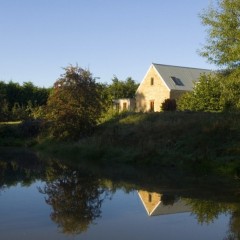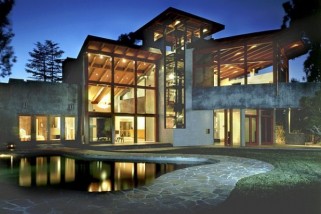Australia Uncovered: Sandstone Barn Turned into Fantasy Retreat
With clear water, picturesque coastline, fertile soils and vast national parks, Tasmania is a magical place. However, there is much more to it than the stunning views and landscapes. The 26th largest island in the world is also lucky to have an amazing array of beautifully-retained 1800’s historical properties. While the majority have been renovated and brought to the 21st century, visitors can still experience the two-centuries-old properties in a unique way. Armytage House is amongst these antique buildings with rich history. Situated in Bagdat, near Hobart, in a charming rural area, the almost 200-year-old building used to serve as grain storage facility to what was back then the Armytage family main residence – Milford Manor. Today the sandstone barn has been renovated and turned into a self-contained luxury vacation retreat. Secluded amidst lush orchard and flower gardens with a small dam and a creek running by, the place allows travellers to rest far away from the busy modern-day life. It is truly amazing that such an impressive construction was once a mere storage unit. With two bedrooms, bathroom and a kitchen which will make any chef drool, Armytage House stuns with its quiet elegance. The kitchen and one of the bedrooms take up the ground floor while the second sleeping zone is set up on mezzanine level overlooking the living area. The renovation works complement the traditional colonial architecture. Tasmanian timber and leather decorate the interior to create a luxurious finish while the exterior has been fully preserved from the hand-made bricks to the dazzling sandstone. The open-plan layout of the barn makes transition between the living area and the kitchen. The mixed wood tones, stone and terracotta flooring create the perfect rural atmosphere to help visitors relax in a modern yet calm domestic environment Outdoors, you will find a charming fireplace, patio, brick oven and a BBQ facility – the perfect equipment to have a nice typical Australian BBQ party. Aside from the gardens and rural areas, you will also find plenty of amazing sites to explore in the region like wineries, bric-a-brac markets, artisan food producers and many more. Images courtesy of Home Away. ...
Funky Zen Bungalow
Implementing Zen elements in your home décor is a trend that is certainly not going to fade away any time soon. But there are more reasons why you should consider adding them to your home. Let’s be honest, we could all benefit from a little bit of Zen in our lives and our dominions. A little bit of serenity and positive energy never hurts. And where better to begin implementing a Zen philosophy than the place closest to our hearts – home. Today, I decided to feature a design by Kim Smart of a 1929 Craftsman Bungalow in San Diego, California. While Californian beach housing is famous for their funky, laid-back style, it’s always refreshing to see a new interpretation on a subject we have all seen before. Another reason, I decided to feature this particular project is that I strongly believe the landscaping and the open-space design is just what our Australian homes would benefit from. Laid-Back Zen Exterior OK, here we don’t see the mandatory water feature which is one of the signature looks of Zen home decoration but we find a splendid multi-level Trex deck which simply invites you to enjoy the sunshine (while sipping a cocktail). A plain wall has been turned into a dazzling focal point with a colourful glass installation. What you don’t see on the photo is that once the sun hits the glass, vibrant reflections of the coloured glass dance on the wall. Free-Flow Interior Natural materials are an essential part of Zen elements at home. Therefore, the hardwood flooring and the Arcadia tree kitchen sideboard make perfect sense. As you can see from all the pictures, the furnishing is arranged to make the most of the natural light flowing in from the vast windows. The flow of the space remains uninterrupted. The living room is divided into two zones – a conversational area and a small home office. The glass cloth wallpaper is a perfect backdrop of the space and gives the work zone a Zen, organic feel. You can view all the pictures of the beautiful bungalow...
Castles of Love: Romantic Gestures & Buildings
Love stories of damsels in distress and brave knights on white horses – this is part of our history and cultural ancestry. The biggest modern day reminder of Medieval heroes and grand romantic gestures are castles. There is something about those monumental buildings with vast, lush gardens and prodigal furnishing that makes us dream and feel all nostalgic. Influenced by ancient mythology, Geek and Roman culture some castles simply throw us in awe. However, there are a few of them which awaken even stronger feelings when you see them. They are the castles of love – eternal monuments of love declarations expressed through architecture. Since Valentine’s Day is just at our doors, I decided to step back in history and find some of the most romantic gestures ever made by mighty men for their fair maidens. Taj Mahal – The Tragedy of a Love That Knows No Boundaries If we have learnt one thing from our history, it’s that stories of tragedies echo through the centuries while happy ones get quickly forgotten. Taj Mahal is a mausoleum, built in memoriam of a loved one. Its construction was ordered by Mughal emperor Shah Jahan after the death of his third wife Mutmaz Mahal. Heartbroken after the lost of his dear one, Jahan ordered the construction of a tomb which would remain in history as the most magnificent shrine created by a man for a woman. The unique architecture combining Persian, Islamic and Indonesian styles, the original (albeit already stolen) lavish lapis lazuli and turquoise decoration and translucent white marble have earned Taj Mahal a rightful place amongst the Seven Wonders of the World. Kellie’s Castle – An Unfinished Love Letter Kellie’s Castle is the oldest castle built in Malaysia. The project was started in 1915 by Scottish landowner William Kellie Smith as a present for his wife. Having blessed him with a son, she was incredibly homesick in a far away country with far too different culture. The building plan was magnificent combining Moorish, Indian and Greco-Roman styles. However, the construction didn’t go as planned after the Spanish flu epidemic took the lives of over 70 Indian workers. To please the locals and convince them to continue building the castle, Kellis created a Hindu temple just next to the castle. Despite his best efforts he never got to finish his love declaration as he died of pneumonia shortly after a trip to England where he went to retrieve a lift for the castle tower. Thus, the Kellie’s Castle remained an unfinished love letter to a loved one. Today, you can still see the remains of what was about to become...
1888 Hotel – Where Instagram Meets Hospitality
One of the strongest indicators that social media rules the world is an enigma which first occurred in Span. In August 2013, the world’s first (but probably not last) TWITTER hotel opened doors. With Twitter-themed rooms and special hashtags for room service orders, the luxury resort snowballed a new era in the hospitality industry. Just a few months later in Sydney, Australia, 1888 Hotel launched a genius marketing campaign for Instagram users. From a special spot for selfies to monthly contest for the best snap shot taken at the premises of the establishment, Instagram fans enjoy preferential treatment. Something more, users with over 10,000 followers receive a complimentary overnight accommodation. It’s only natural to wonder why Instagtam and not Facebook or Pinterest? Back in 1888 Kodak released it’s first camera and the property owners want to pay respect to the company’s history. Moreover, as you might have already figured out, the building of the hotel was constructed in 1888. Initially used as a wool storage facility, the structure is a fine example of typical Australian architecture. Vast period windows, exposed bricks and high ceilings dominate the space. After 2 years and $30 million AUD worth of renovations, 1888 hotel was opened to reveal an unique design and décor. Pops of vivacious colours (yellow, blue, magenta and deep purple) warm up the subtle stony-grey colour scheme. Punchy Australian art decorates both the rooms, suits and lofts and the community areas. With 90 rooms, 1888 hotel offers several accommodation options. Forget about the sterile hotel rooms you have seen. Each of the spaces in the establishment has it’s own unique style and charm. From standard-sized two-person bedrooms with mezzanine bathrooms to spacious loft with a spectacular view of Sydney – there is something for everyone. The presidential suite even has its own...
Challenging Urban Design: Cambodian Temple-Inspired Home
The ancient ruins of Angkor Wat – the largest religious temple in the world, have inspired Sydney architect Drew Heath to create a house inspired by its archaic wild beauty. Just last month the unique construction won the 2013 National Award for Architecture in the residential category. Dubbed the venerable Irish name Tír na nÓg (“land of youth”), the building mimics the overgrown outlying of the fist Hindu temple. Once a worker’s cottage, today turned into a magnificent construction – the dwelling received Atralia’s most prestigious acknowledgement for exceptional design the 2013 Wilkinson Award for Residential Architecture from the NSW Australian Institute of Architects. Situated in McMahon’s Point – one of Sydney’s most prominent suburbs, Tír na nÓg is an extraordinary example of green urban design. Situated on a quiet street in one of Sydney’s most luxurious suburbs, Tír na nÓg boasts natural bamboo fences and thick foliage to recreate the abandoned beauty of Angkor Wat – the temple lost in the jungle’s heart. Just like the ancient city, the property seems lost in the omnibus greenery. Drew Heath, the designer of the building and owner of Drew Heath Architects, was so fascinated by the Cambodia’s top tourist attraction that he decided to take on the challenge of recreating the solitude of the forgotten ruins in one of Sydney’s most densely populated suburbs – McMahon’s Point. Despite the ambitiousness of the project both jury and public agreed he has succeeded. With its unique floor plan and greenery overflowing the landscape, the house looks both insulated from the rest of the suburb and like an inseparable part of it. The home features several bedrooms and sleeping areas which can host up to 12 people. The old cottage’s backyard has been turned into a sunlit summer pavilion connected to the main building via a central garden. Tír na nÓg’s kitchen is spacious and can be further extended to the garden thanks to the floor-to-ceiling sliding glass panels. It also connects to a contemporary reading room. Indoor and outdoor spaces (including the garden, the bamboo fences and the rooms) all tumble over 12 different levels making the layered design of the building truly extraordinary. With natural sunlight penetrating every level of the house and the unique garden-centred arrangement along with the summer/ winter bathrooms make Tír na nÓg stands to prove why Australia’s exceptional urban architecture is world-widely recognised. Challenging urban design should always be...
House of Bottles
There are 1001 ways to recycle and help protect the environment. From separating your residential waste in different containers to using energy saving appliances. However, some home-owners use their creativity to build houses from the most unusual materials. While the concept of using bottles to make dwellings is not a novelty, I am fascinated with the patience and determination of one person. Tito Ingenieri an Argentinian artist has utilised over six million recycled glass bottles to build a magnificent home for himself and his pet Captain Nemo. The incredible structure is known as ‘Casa de Botellas’ or ‘House of Bottles’. The artist has been working on this project for 21 years. Years of gathering glass bottles, cleaning them and arranging them layer after layer until the entire unit was complete. In an interview for Argentina Independent, the 57-year-old sculptor states: ‘You could say that I’m one of time’s castaways. I am an art labourer and I didn’t have a house so I decided to make one‘ Just like that Tito made the decision to build what is by far one of the most extraordinary homes I have ever seen. The persistence and love with which the artist has gathered each bottle and then laid it so that it fits the gigantic puzzle that is ‘Casa de Botellas’. However, the bottle structure is by far not the only inspiring thing about his home. Everyday items turned into enchanted art pieces lurk behind every corner of the establishment. After 21 years of recycling, upcycling and manual labour, Tito’s own home is now open for visitors. As you can see from the pictures below its interior is even more dazzling than the exterior. There is only one thing we would like to remind. Cleaning glass bottles is hard enough on its own but when you throw in that they have been left to the mercy of nature elements, it gets even more difficult. Making the Bottle House With a framework made of re-claimed iron, the structure has an unusual shape which totally corresponds with Ingenieri’s personality and style. Just like the rest of the construction is created from re-purposed materials like the glass bottles, the main framework incorporates 50-year-old wagon wheels and even port-hole windows. Thanks to the stable foundation, the aggregated pressure from the bottles is relieved preventing the bottles from shattering into million pieces. Tito’s bottle house not only showcases his creativity and vision, it also stands as a monument of community spirit. Most of the bottles – different in shape, colour and style, are donated by local clubs and even authorities. Beer bottles find their rightful spot right next...

















